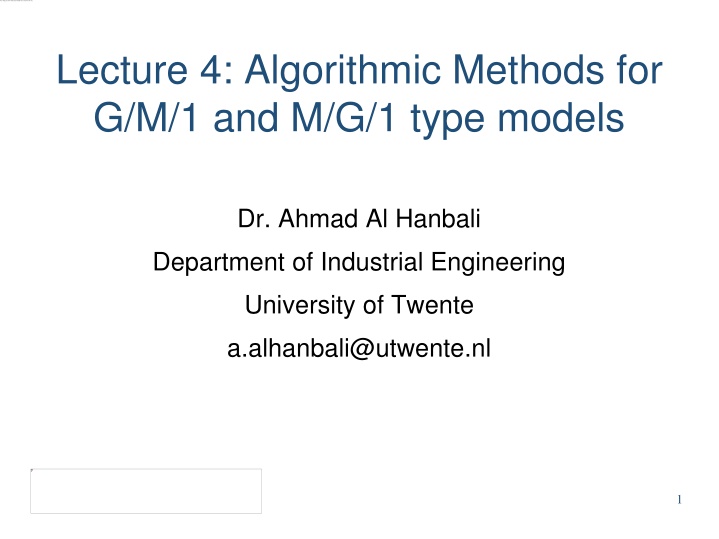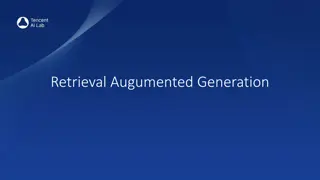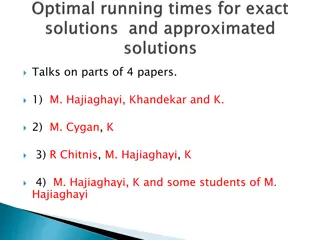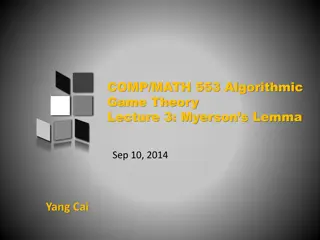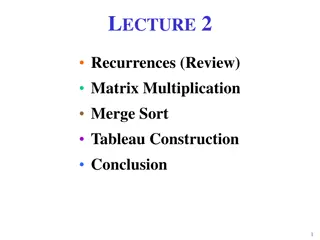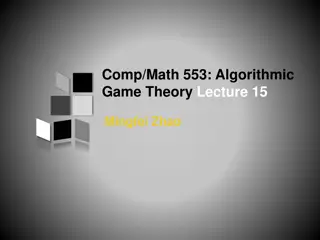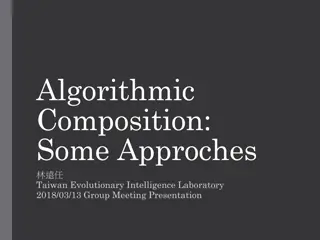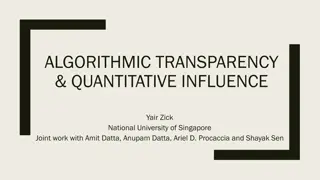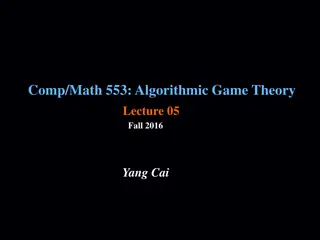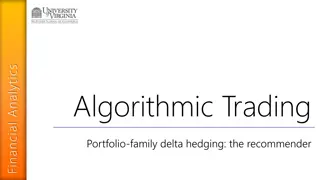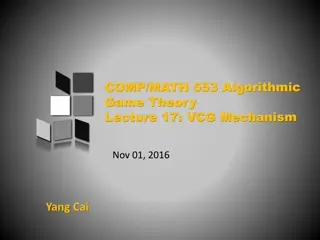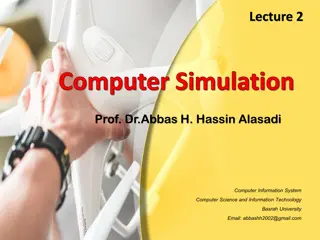Lecture 4: Algorithmic Methods for G/M/1 and M/G/1 type models
This lecture delves into algorithmic methods for continuous time Markov chains with infinite state space, focusing on G/M/1 and M/G/1 type models. Explore equilibrium distribution and skip-free processes in these systems.
Download Presentation

Please find below an Image/Link to download the presentation.
The content on the website is provided AS IS for your information and personal use only. It may not be sold, licensed, or shared on other websites without obtaining consent from the author.If you encounter any issues during the download, it is possible that the publisher has removed the file from their server.
You are allowed to download the files provided on this website for personal or commercial use, subject to the condition that they are used lawfully. All files are the property of their respective owners.
The content on the website is provided AS IS for your information and personal use only. It may not be sold, licensed, or shared on other websites without obtaining consent from the author.
E N D
Presentation Transcript
Lecture 4: Algorithmic Methods for G/M/1 and M/G/1 type models Dr. Ahmad Al Hanbali Department of Industrial Engineering University of Twente a.alhanbali@utwente.nl 1
Lecture 4 This Lecture deals with continuous time Markov chainswith infinite state space as opposed to finite space with skip-free in one direction as opposed to QBDs Lecture 3 Objective: To find equilibrium distribution of the Markov chain Lecture 4: G/M/1 and M/G/1 type models 2
Background (1): G/M/1 queue Interarrival time of jobs is arbitrary distribution, ??(?) with mean 1/?, and inter-arrival times are iid Jobs service times are iid exponential rvs with rate ?. Inter- arrivals and service times are independent Service discipline can be Fisrt-In-First-Out (FIFO) Under above assumptions, the nbr of jobs in G/M/1 queue at arbitrary time ? DOES NOT form a Markov chain Let ?(??) denote the number of jobs in the queue just before the ?-th arrival. The process {?(??),? = 0,1, } is a discrete- time Markov chain Let ?? denote the probability that exactly ? jobs are served during an inter-arrival time given there are at least ? jobs present at the start of inter-arrival. Then ?? reads ??? ?! ? ?????(?),? = 0,1, , and ??= ?>??? ??= 0 3 Lecture 4: G/M/1 and M/G/1 type models
Background (2): G/M/1 queue ?0 ?1 i i-1 i+1 0 1 ?? ?? ?2 The transition probability matrix is given ?0 ?1 ?2 ?3 ?4 ?0 ?1 ?2 ?3 ?4 0 ?0 ?1 ?2 ?3 0 0 ?0 ?1 ?2 0 0 0 ?0 ?1 . ? = For stable case with ? < ? we find ??= 1 ? ??, (Geometric distribution) where ? is the unique root in (0,1) of ? = ? ? ? 1 ? ?. 4 Lecture 4: G/M/1 and M/G/1 type models
Definition G/M/1-type processes: skip-free process to the right A 2-dimensional irreducible continuous time Markov process with states (?,?), where ? = 0, , and ? = 0, ,? 1 Subset of state space with common ? entry is called level ? (? > 0) and denoted ?(?) = {(?,0),(?,1), ,(?,? 1)}. ?(0) = {(0,0),(0,1), ,(?,?0 1)}. This means state space is ? 0?(?) Transition rate from (?,?) to (? ,? ) is equal to zero for ? ? 2 For ? > 0, transition rate between states in ?(?) and from ?(?) to ? ? + 1 ,? ? 1 , ,?(0)are independent of ? Lecture 4: G/M/1 and M/G/1 type models 5
Skip-free to the right process Order the states lexicographically, i.e., 0,0 , , 0,?0, 1,0 , , 1,? , 2,0 , , 2,? , , the generator of the skip-free process has the following form: ?00 ?10 ?20 ?30 where ?0 and ?2are nonnegative ?-by-? matrices; ??is square matrices of size ?; ?00is square matrix of size ?0; ??0?0-by-? and ?01?-by-?0 nonnegative matrices. Note, (?00+ ?01)? = 0, (?10+ ?11+ ?0)? = 0, and (?0?+ ? ?01 ?11 ?2 ?3 0 ?0 ?1 ?2 0 0 ?0 ?1 0 0 0 ?0 ? = Lecture 4: G/M/1 and M/G/1 type models ?=0 ??)? = 0 6
Stability of G/M/1-type process ??. ? is the generator describing transitions of the Let ? = ?=0 M/G/1-type process between level states (i.e., in the vertical direction) Theorem: Assume the Markov chain with generator ? is irreducible with equilibrium distribution,?? = 0,?? = 1. The G/M/1-type process is ergodic if and only if ? 1 ??? (mean drift condition) ??0? < ? ?=1 Interpretation: ??0? is mean drift from level ? to ? + 1. ? ?=1 ? 1 ??? is the mean drift from level ? to levels smaller than ? for large ? 7 Lecture 4: G/M/1 and M/G/1 type models
Equilibrium distribution of G/M/1- type processes Let ??= (?(?,0),..,?(?,? 1)) and ? = (?0,?1, ) then equilibrium equation ?? = 0 reads ?=0 ?=0 Theorem: if the G/M/1-type process is ergodic the equilibrium probability distribution then reads ??= ?1?? 1,? 1, where ? is the minimal nonnegative solution of the matrix equation ?=0 Interpretation: ? = ?0? same as in QBD process ?? ??0= 0, ?0?01+ ?1?11+ ?=2 ??+???= 0, ? 1 ????= 0, ????= 0 8 Lecture 4: G/M/1 and M/G/1 type models
Equilibrium distribution of G/M/1- type processes(cnt'd) A direct result of the previous theorem is that spectral radius of ? is < 1 and (? ?) is nonsingular Lemma: The stationary probability vectors ?0and ?1 is the normalized unique solution of ?0,?1? ? = 0,0 , where ? ? is the generator given by ?00 ?=1 Normalization is done by letting ?0??0+ ?1? ? 1??= 1. Note ??0 and ?? are column vectors of ones with size ?0 and ?, respectively Proof: follows by inserting ??= ?1?? 1in the balance equations ?01 ? ? = . ?? 1??0 ?? 1?? ?11+ ?=1 Lecture 4: G/M/1 and M/G/1 type models 9
Finding R Rearrange the equation of the rate matrix: 1 ???? ?1 ? = ?0+ ?=2 Fixed point equation solved by successive substitution ??+1= (?0+ ?=2 ?? It can be shown that ?? ? for ? In many queueing systems for large ?, ?? 0. Truncating ?=2 ?? 1, with ?0= 0 ???)?1 ? ??? ??? ?=2 ?? Lecture 4: G/M/1 and M/G/1 type models 10
Special case: GI/PH/1 queue Consider the case ?01= ?0 and ?11= ?1 The matrix ??0 is a rank one matrix satisfying ? ????. ??0= ?=0 where ? is the initial state probability vector of the service time phase-type distribution Lemma: The stationary probability vector of GI/PH/1 embedded at the moment of arrivals ??= ?0??, where ?0= ? ? ? 1? 1?. Proof: in this case ? ? will be of rank one Lecture 4: G/M/1 and M/G/1 type models 11
Definition of M/G/1-type processes: skip-free process to the left A 2-dimensional irreducible continuous time Markov process with states (?,?), where ? = 0, , and ? = 0, ,? 1 Subset of state space with common ? entry is called level ? (? > 0) and denoted ?(?) = {(?,0),(?,1), ,(?,? 1)}. ?(0) = {(0,0),(0,1), ,(?,?0 1)}. This means state space is ? 0?(?) Transition rate from (?,?) to (? ,? ) is equal to zero for ? ? 2. For ? > 0, transition rate between states in ?(?) and from ?(?) to ? ? 1 ,? ? + 1 , , are independent of ? Lecture 4: G/M/1 and M/G/1 type models 12
Skip-free to the left process Order the states lexicographically, i.e., 0,0 , ,( ) 1 , 1,0 , , 1,? 1 , 2,0 , , 2,? 1, , the generator of the QBD has the following form: ?00 ?10 0 0 ??is square matrix of size ?; ?00is square matrix of size ?0; ?0??-by-?0 and ?10 ?0-by-? nonnegative matrices. Note, the sum of the rows elements should be zero. 0,?0 ?01 ?1 ?0 0 ?03 ?3 ?2 ?1 ?02 ?2 ?1 ?0 ? = Lecture 4: G/M/1 and M/G/1 type models 13
Stability of M/G/1-type processes ??. ? is the generator describing transitions Let ? = ?=0 of the M/G/1-type process in the vertical direction. Theorem: Assume the Markov chain with generator ? is irreducible with equilibrium distribution,?.?. ?? = 0,?? = 1, and with ?=1 ergodic if and only if ??0? > ? ?=2 ? 1 ??? (mean drift condition) ??0?? finite. The M/G/1-type process is 14 Lecture 4: G/M/1 and M/G/1 type models
Equilibrium distribution of skip-free to the left processes Assume M/G/1-type process is ergodic. The minimal nonnegative solution ? of ?=0 is then stochastic, i.e., ?? = ?, Interpretation: ?,? -element of ? represents probability to jump for the first time to level ? 1 by entering state ?,? 1, given process starts in (?,?) at time 0 Theorem (Matrix analytic): Assume M/G/1-type process is ergodic then equilibrium probability of ? ? gives ????= 0, ??= ?0 ??+ ?=1 where, ??= ?=0 ? 1?? ??+1 ? 1,? = 2,3, , ?1 ?0?+???, ??= ?=0 ??+???,? = 1,2, . 15 Lecture 4: G/M/1 and M/G/1 type models
Finding ? In many queueing systems for large ?, ?? 0. Using this, ?? and ?? 0, then the following recursion (backward) can used ??= ?0?+ ??+1? ??= ??+ ??+1? In this case, it is reasonable to truncate the infinite sum of ??+1 at K The matrix ? can be found recursively as follows ??+1= ?1 ???? It can be shown that ?? ? for ? ? ?,? = 1,2, , with ?0= 0. 1?0+ ?=2 16 Lecture 4: G/M/1 and M/G/1 type models
Probabilities ?0 and ?1 Theorem: The stationary probability vectors ?0and ?1 is the normalized unique solution of ?0,?1? ? = 0,0 , where ? ? is the generator of an irreducible chain given by ?=0 Normalization should be done such ?=0 ? ? is M/G/1-type process restricted to ? 0 & ?(1), ? ? e=0 Special case: Special case: ?10= ?0 Recursion in the theorem in slide 15 will also hold from for ? = 1. ? ? = ?=0 solution of ?0? ? = 0 ?01+??? ?=0 ?00 ?10 ? ? = . ?1+??? ??? = 1 ?0???. Moreover, ?0is the normalized unique 17 Lecture 4: G/M/1 and M/G/1 type models
Finding ?0: special case ?10= ?0 ?0?, ? = ?=1 ?? is irreducible and let ?? = 0,?? = 1 ? = ?? (load measure) Theorem: Assume the generator of skip-free to the left process and ? are irreducible. If the skip-free to the left process is ergodic, then ? = ?0?? ? + ? ? + ?? 1? Proof Proof: Similar Theorem 4.8 in Bini et al. (2005) ??0??, ? = ?=1 ???? Let ? = ?=0 Assume ? = ?=0 Using ?0? ? = 0 and additional equation in the previous Theorem, then ?0 can be uniquely determined It is also possible to find ?? = ?=1 as function of ?0, ?, ?,?, ???? in closed form 18 Lecture 4: G/M/1 and M/G/1 type models
Example: Geo?/D/1 with slot reservations in care pathway patients Priority patient reserves time slot between L and H slots in future: 1. If time slot L is occupied by a regular patient, the priority patient takes the position of the regular patient, and all regular patients from position L onward are shifted to the next time slot 2. If slot L is occupied by priority patient, then new priority patient moves to the first available slot in the interval L + 1, . . . , H that is not occupied by a priority patient, and takes that position. 3. If all slots in the interval L, . . . , H are occupied by priority patients, the new priority patient is blocked 19 Lecture 4: G/M/1 and M/G/1 type models
Example: Geo?/D/1 with slot reservations in care pathway patients ?2(? ),? 1, total number of regular patients waiting in the queue at the end of each time slot (level state) ?(? ),? 1, a state vector of length H with entries denoting which slot in the set {1, . . . , H} contains a priority patient (phase state) Two-dimensional process (?2(? ), ?(? )) is discrete time Markov chain with transition probability matrix M/G/1- type form 20 Lecture 4: G/M/1 and M/G/1 type models
Example: Geo?/D/1 with slot reservations in care pathway patients One-step transition of the priority patients state ? ? are independent of the number of regular patients present ? and ? the one-step transition probability matrix of priority patients ? ? ? ? + 1 ?? can be rewritten as ?? ??, where ? is the diagonal matrix, ?0 can be written as ?0 ??, where ? is the diagonal matrix, and ??can be written as ??? We find that the equilibrium probability vector of is matrix geometric ??= ?0? ?2? ??? 1,? = 1,2, , where ? = ?1?0 ? + ?2? 1 and ?is minimal nonnegative solution of quadratic matrix equation Let ??= 1 ?2?2 21 Lecture 4: G/M/1 and M/G/1 type models
References Bini, Latouche, Meini, Numerical Methods for Structured Markov Chains Oxford University Press, 2005. G. Latouche and V. Ramaswami (1999), Introduction to Matrix Analytic Methods in Stochastic Modeling. SIAM. M.F. Neuts (1989), Structured Stochastic Matrices of M/G/1 Type and Their Applications. Marcel Dekker, INC. M.F. Neuts (1981), Matrix-geometric solutions in stochastic models. The John Hopkins University Press, Baltimore. M.E. Zonderland, R.J. Boucherie, A. Al Hanbali. Appointments in care pathways: the Geo^x/D/1 queue with slot reservations. Queueing Systems, vol. 79, issue 1 (2015). Lecture 4: G/M/1 and M/G/1 type models 22
